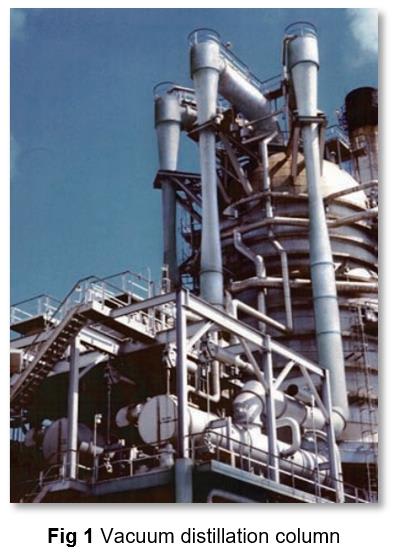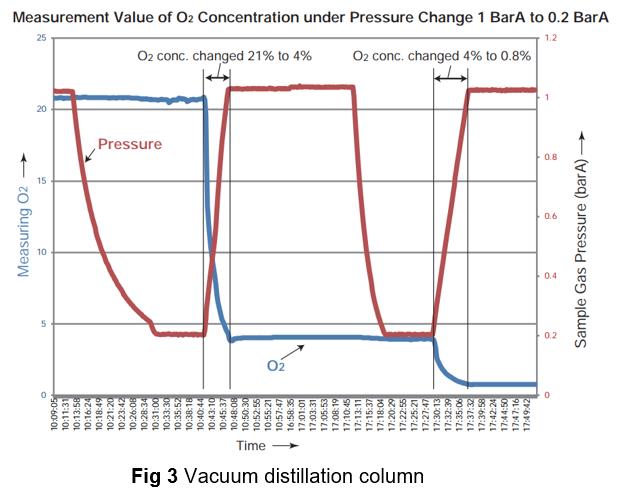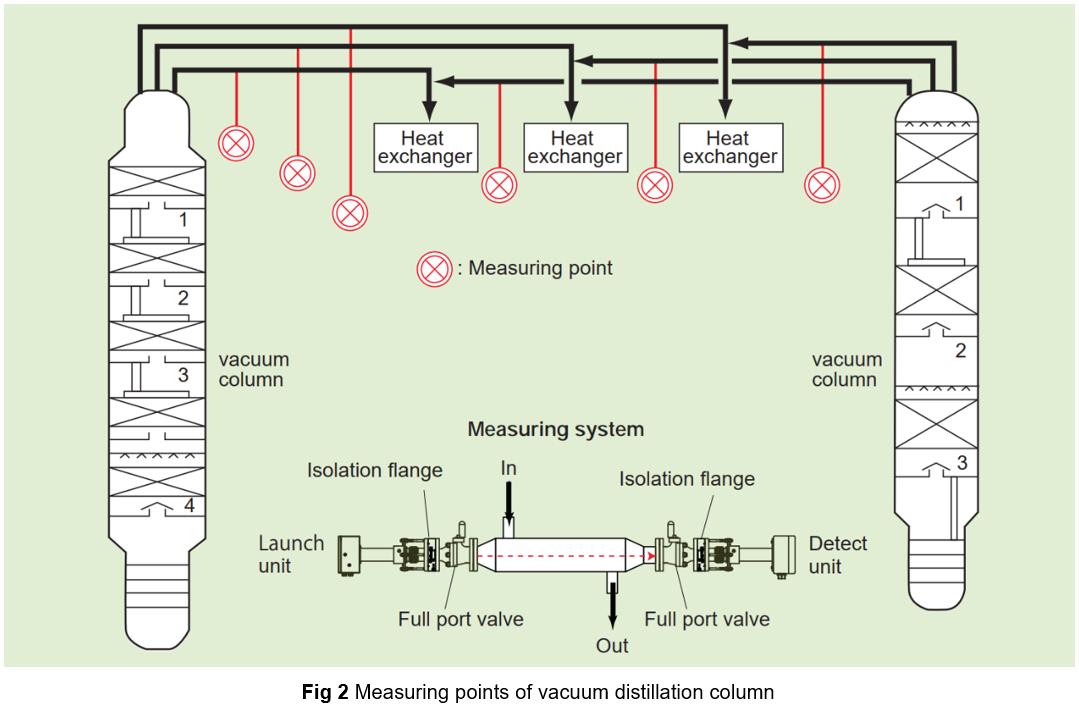Petroleum refining measures hydrocarbon vapor O2 levels to monitor vacuum distillation columns for safety.
 With conventional paramagnetic oxygen analyzers, O2 measurements are extracted and conditioned prior to sample analysis.
With conventional paramagnetic oxygen analyzers, O2 measurements are extracted and conditioned prior to sample analysis.
These extractive sample systems can cause measurement delays, a critical issue in safety related measurements. In addition to the sample lag, sample systems tend to increase the measurement system’s overall complexity, maintenance, and operational costs. Another disadvantage is extractive measurements are point measurements and at times may not provide a proper representation of the process stream being measured. An in-situ TDLS measurement can alleviate conventional technology’s extractive measurement drawbacks.
Process Overview
The vacuum distillation column (see Fig 1 and Fig 2) distills the residual oil from the atmospheric distillation column. The distillation column operates at pressures as low as 2-15 kPa to reduce the overall operating temperature to less than 370°C to avoid any unwanted hydrocarbon cracking. The presence of oxygen in the process, commonly caused by leaks, can lead to potentially explosive conditions. As O2 levels increase toward LEL levels (Lower Explosive Limits) an alarm will occur (typically 2-5 %O2) to immediately purge the vapor line with an inert gas. It is imperative that a reliable, high-speed O2 measurement is maintained to avoid hazardous situations.
Challenges
Conventional Paramagnetic Analyzers
Paramagnetic analyzers require an extractive sampling system that causes measurement response delays, increases overall operational and maintenance costs, and is sensitive to overall process variations and upsets.
Other TDL Analysis Methods
Due to the vacuum conditions of the process stream the O2 absorption spectra becomes narrow and non-linear when using 2f (WMS) analysis methods and requires additional corrections. The direct absorption system (DAS) maintains linearity using spectral area methods and is measuring the direct absorption peak, not a mathematical derivative.
Solutions
 An in-situ TDLS8000 installed on a process leg or bypass stream provides a reliable and high-speed measurement that is representative of the process composition. The in-situ installation eliminates sample lag of an extractive measurement and reduces overall operational and maintenance costs associated with sample handling systems. The high-speed response (2.3 seconds) and onboard diagnostics maintain performance reliability and measurement confidence.
An in-situ TDLS8000 installed on a process leg or bypass stream provides a reliable and high-speed measurement that is representative of the process composition. The in-situ installation eliminates sample lag of an extractive measurement and reduces overall operational and maintenance costs associated with sample handling systems. The high-speed response (2.3 seconds) and onboard diagnostics maintain performance reliability and measurement confidence.
Figure 3 shows O2 measurements of 21%, 4%, and 0.8% under changing gas pressures from 1-0.2 BarA. As the pressure changes, the overall spectral shape is affected. Yokogawa’s TDLS analysis methods, however, maintain linearity and accurately compensate for these changes to continuously make an accurate O2 measurement.
Key Benefits
- By eliminating the need for a sampling system, the TDLS8000 reduces maintenance and operational costs.
- It provides a high-speed response to changes in O2 concentration (2.3 seconds).
- It is SIL2 rated device with SIL3 capability.

Industries
-
Oil & Gas Downstream
The oil & gas downstream industry has been facing an increasing number of challenges in recent years. These include the changing characteristics of the feedstock to be processed, aging of process facilities and equipment, rising cost of energy, lack of skilled plant operators who can run a refinery safely and efficiently, and the ever-changing requirements from both the market and the customer.
Over the years, Yokogawa has partnered with many downstream companies to provide industrial solutions focused on solving these challenges and problems. Yokogawa's VigilantPlant solutions have helped plant owners to achieve maximum profitability and sustainable safety within their plants.
-
Refining
In the ever-changing marketplace, refineries are seen not only as crude processing units but also as profit centers. At the same time, there is a keen awareness of the need for safety at such facilities. A total production solution that encompasses planning, scheduling, management, and control is required to achieve long-term goals for profitability, efficiency, and environmental protection. With years of expertise in the automation field, Yokogawa can bring you affordable total solutions for improved operability and a cleaner world.
Related Products & Solutions
-
In-Situ Gas Analyzer TDLS8000
Yokogawa’s new TDLS8000 houses all of the industry’s leading features in one robust device. The platform design is for in situ measurements which negates the need for sample extraction and conditioning.
-
Tunable Diode Laser Spectrometers
- Tunable Diode Laser Spectrometers (TDLS) laser-based gas analyzers
- Fast-update optical analysis
- Safe and environmentally responsible according to industry standards
Have Questions?
Contact a Yokogawa Expert to learn how we can help you solve your challenges.
